1960s Fashion For A New Generation
1960s Fashion was all about youth, with London at it’s epicentre.Time magazine declared on its cover of April 1966 that this issue was all about London… the swinging city. The artwork was hilarious: a stoned blonde girl in a short black and white op-art dress, white tights and red Mary-Janes stood behind a frazzled, long-haired man. Roger Daltry, in a “Who” tshirt emblazoned with the Union Jack and Union Jack sunglasses stood next to him and screamed into a microphone. A woman with a Vidal Sassoon bob and graphic eyeliner leaned on a roulette table smoking from a long cigarette holder, while in the background were the bright lights and big sights of London. It did sum up all the fun parts of the city and the fashions of the decade.
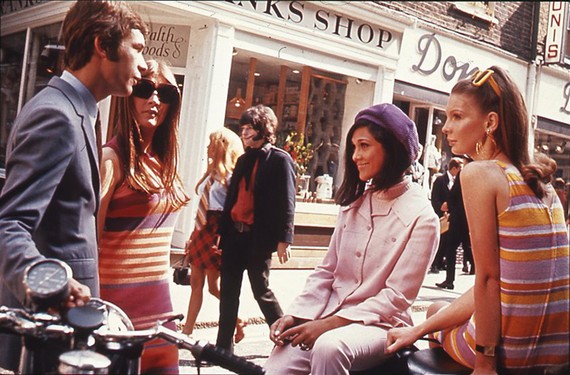
Teenagers in Carnaby Street, London, 1966
“Dreamers… Doers. Here. Now. Youthquake 1965”. wrote Diana Vreeland in Vogue of that year.
The 1960s were a time when popular culture and 1960s Fashion trends shifted as a whole towards a new, noisy, bright and happy emphasis on youth. This process had begun in the 1950s with the invention of the teenager, where a person was no longer a child but did not yet have to take on the roles or responsibilities of their mothers and fathers. Teenagers, and people in their twenties, now had a bit more money in their pockets and they wanted to spend it on fun, ephemeral things like 1960 fashion, records and having fun.
Fashion itself began to become more disposable, so instead of carefully choosing a well cut, good quality suit that would be expected to last for decades, the fashionable crowd wore cheaper things in experimental bright colours or crazy “fabrics” like vinyl. The mood was hedonistic, but events like the space race and the cold war both provided inspiration for futuristic designs and held everyone in all night long, nervous discussion about whether “They would push the button” and suddenly the whole world would disappear in a nuclear explosion.
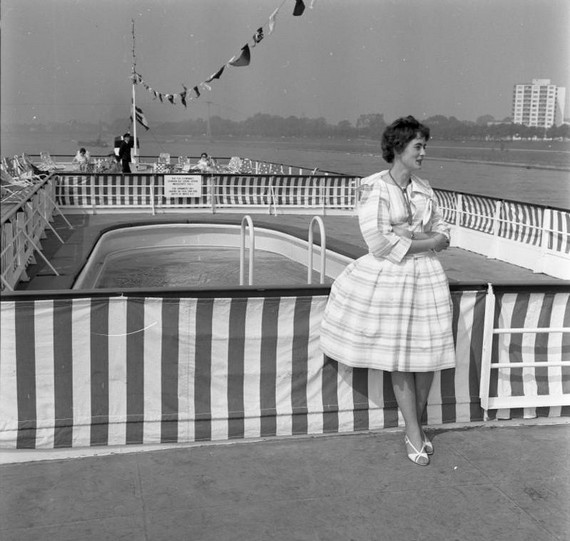
Woman wearing cotton print striped dress on board the cruise ship Europa, 1960
Women’s daywear in 1960s clothing styles
Of course, the 1960s were famed as the birthday of the mini skirt. Although some miniskirts could be very very short, micro minis were quite rare and in general anything more than an inch above the knee was classed as a mini skirt.
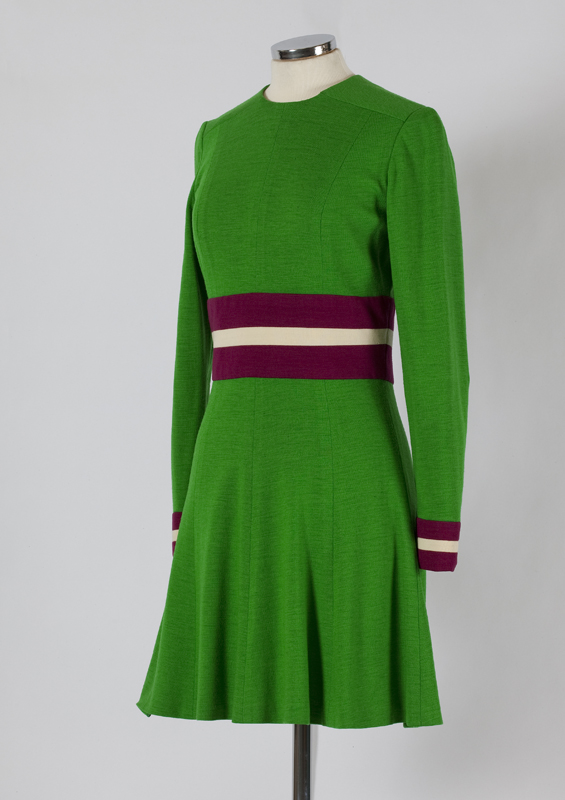
1960 Mary Quant green, purple and white jersey minidress
There is some contention as to whether Mary Quant actually invented the garment, as she is widely credited to have done, but she certainly made great mini skirts, often as part of a matching skirt suit in bold patterns. The clothes were more youth oriented but there was still a lot of precise tailoring, evidenced in well made skirt suits and shift dresses. The difference was often in brighter colours, bolder patterns and larger or novelty buttons. Although the 1960s were the beginning of “fast fashion”, clothes were not that cheap and usually well made.
Barbara Hulanicki, the founder of one the most wildly popular clothing brands of the decade, Biba, reminisced about creating a “pile it high and sell it cheap” culture, but many young working women I know from that generation who were for example junior reporters have told me they could never have afforded an outfit from Mary Quant or Biba. Foale and Tuffin were another company making cute suits and mini dresses for the younger crowd.
The fabrics for most of these sixties designs of shift dresses and A Line skirts was quite thick and stiff, enabling a simple cut to hold its shape.
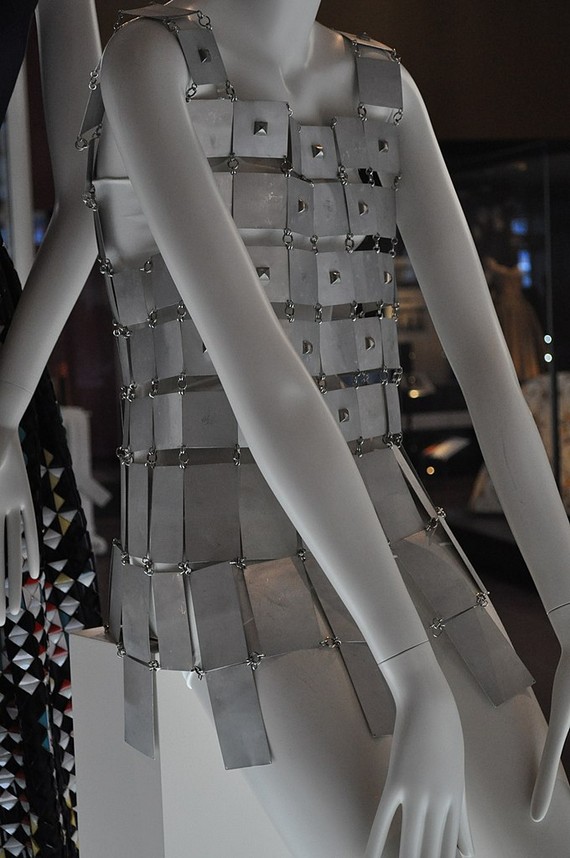
Paco Rabanne aluminium tunic, 1967
The Space Age in 1960s Fashion
Paco Rabanne, Pierre Cardin and Andre Correge were three designers of fashion in the 1960s who aimed for the avant-garde inspired by the space race, with Paco Rabanne in particular making dresses that were eye-catching but impractical. He made mini dresses made of discs of clear perspex or metal which were joined together with metal hoops. They looked great but apparently the discs could easily nip your nipples, or cut you with their sharp edges, be unpleasantly cold or just be so heavy overall that it was like dragging a suit of armour around with you.
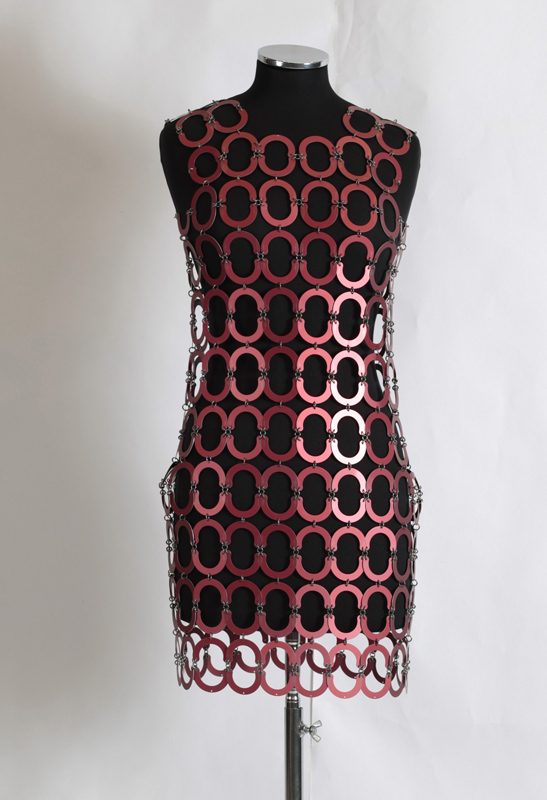
Chainlink outfit designed by Paco Rabanne, late 1960s
Which was a shame because Paco Rabanne was the costume designer for the space comedy Barbarella, and there’s no doubt that many women would have liked to dress just like the titular heroine of the film, played by Jane Fonda who looked ravishing in every scene.
“Cardin’s contribution to modern living may be practical but it’s rather a shock” commented one magazine reviewing the designer’s works. The short knitted dresses worn with warm tights were easy to move around in, even though the helmets that went with them might have hindered freedom of movement a bit. And I’m not sure how easy a wool and perspex dress is to bung in the washing machine.
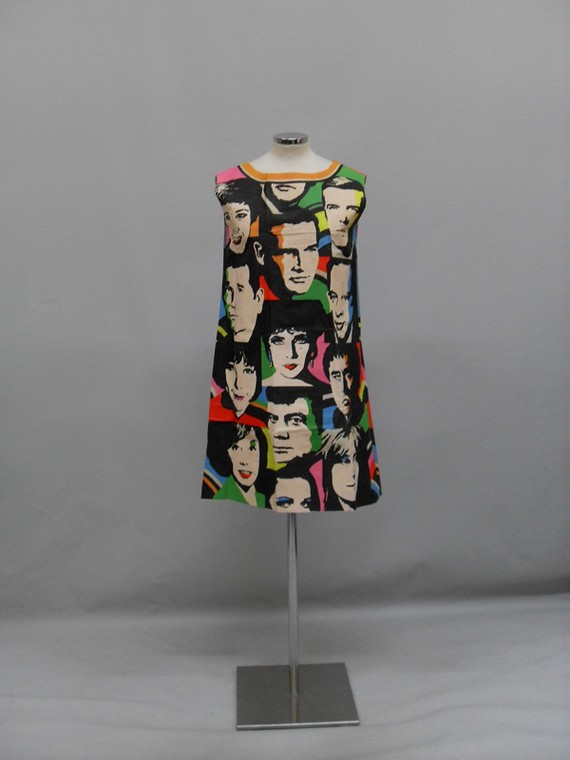
The Big Ones of 68 paper dress by Universal Studios, American, 1968
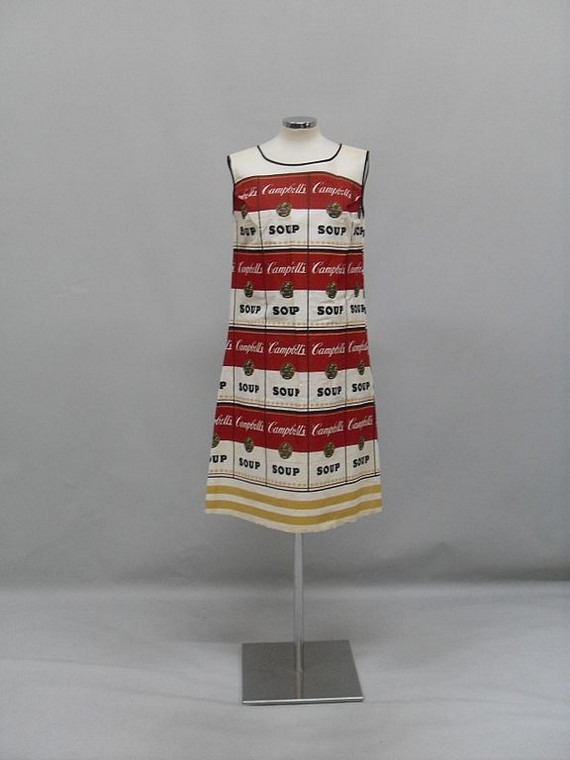
Campbells soup paper dress, 1967
1960s paper dresses
Easier to deal with, perhaps, were the disposable paper dresses. Cut to a very simple two-dimensional shift dress pattern, these dresses which were in fact made from tough cellulose with strong seams, and didn’t rip or dissolve in the rain. They often carried promotional prints, like the very well-known Campbell’s soup can version, yours for only two soup labels.
Silver and white were the preferred colours for futuristic 1960s fashion, just like a spacesuit. In actual practical terms, the development of the spacesuit produced lightweight and weatherproof fabric Goretex, which is still in use today.
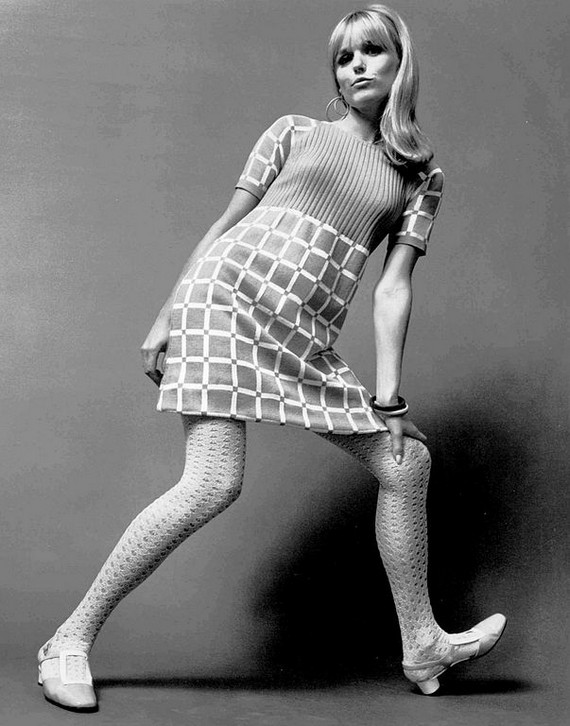
Knitted Sweater dress, 1967
The 1960s fashion Doll Look
Another look in fashion from the 60s was the return to innocence with short ruffled dresses in white and pastel colours, reminiscent of very small girls’ dresses, and childish Mary Jane shoes. These were modelled by extra skinny, flat chested women with enormous eyes, such as the famous Twiggy. Another memorable model from the 1960s was Verushka. Her look and character were completely different from the doll-like Twiggy. Mysterious and sophisticated, the panther-like Verushka often appeared in photoshoots naked but for body paint of her own design.
She wasn’t the only woman to appear in public in either body paint or simply totally naked. The first Woodstock Festival was in 1969 in the USA, and there was the Isle of Wight Festival from 1968-1970. The hippies favoured the odd bout of toplessness or nakedness for festivals and parties or settled for bare feet and floaty clothes, like long skirts and cheesecloth blouses if the weather was inclement. They teamed these with clothing taken from other cultures such as Native American suede and fringing or Indian beads, as a gesture of solidarity with that culture.
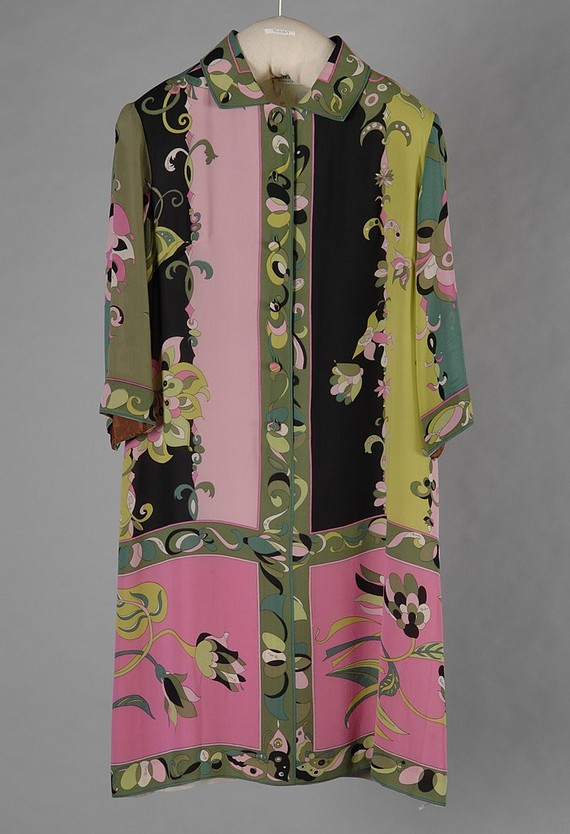
Emilio Pucci bright coloured, patterned silk dress in pink, black and green, 1965
Couture style in 1960s fashion
Totally the opposite, and literally a far more buttoned up appearance was the then First Lady, Jackie Kennedy (also known as Jackie O). She was very ladylike, and wore suits and simple yet elegant shift dresses in block colours. She paired these with carefully coiffed hair, matching hats, button earrings and white gloves. She was a huge style influence for many in the fashion in the 1960s.
For those who preferred their colours loud and clashing, Emilio Pucci provided the rich jet set with swirling patterns on silk blouses and relaxed trousers, a design signature that has changed very little right up to the present day.
Yves Saint Laurent contributed quite a lot to the fashion landscape of 1960s fashion too – as well as his arguably more famous evening wear he designed the safari suit for women and the “Little Lord Fauntleroy” look too, a romantic look replete with silk velvet knickerbockers and lacy collars.
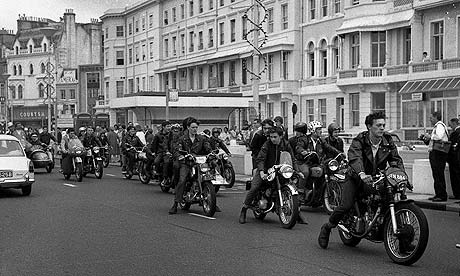
Mods and Rockers riding through Hastings, on the south coast UK, 1964
Street style in the fashions of the 1960s
Street style in 1960s fashion on the whole stayed away from silk and velvet, unless it was the tattered hippy version. Instead a tough new “Modern” look emerged. The Mods was predominantly a male fashion look but there was a female version too, with heavy fringes and quite plain jumpers and pencil skirts just as there was a female version of the Mods arch enemies, the Rockers. Female rockers wore an adapted version of the biker fashions of their boyfriends, with leather jackets, jeans, and tough looking boots.

Cream silk jersey evening gown with silver beading and sequin embroidery by Norman Hartnell, 1960
1960s Evening wear
Another style influence on 1960s fashion was beautiful film star Audrey Hepburn. Her simple style of clothing had been widely copied since the 1950s, and now she appeared in the 1961 hit “Breakfast at Tiffany’s”. For this she was dressed by the couturier Hubert de Givenchy. Her simple little black dress was hugely copied and she continued her association with the couturier, begun in the early 1950s, right through the Sixties, being dressed by him for further films and for appearances and events too. He had even made a perfume for her, called L’Interdit, said to be her favourite fragrance and one she wore constantly, along with thousands of other women on its release.
Couturiers like Givenchy, Yves Saint Laurent and Jean Patou experimented with cut in 1960s fashion, creating clothing that didn’t follow an hourglass figure (or attempt to create one). Instead, Balmain innovated with cleverly cut cocoon dresses, trapeze lines and balloon dresses.
But for couture evening wear, the youth craze was a little bit slower to catch on. For the first half of the decade, dresses were still created with an older client in mind, and traditional designers like Nina Ricci made elegant, full length creations.
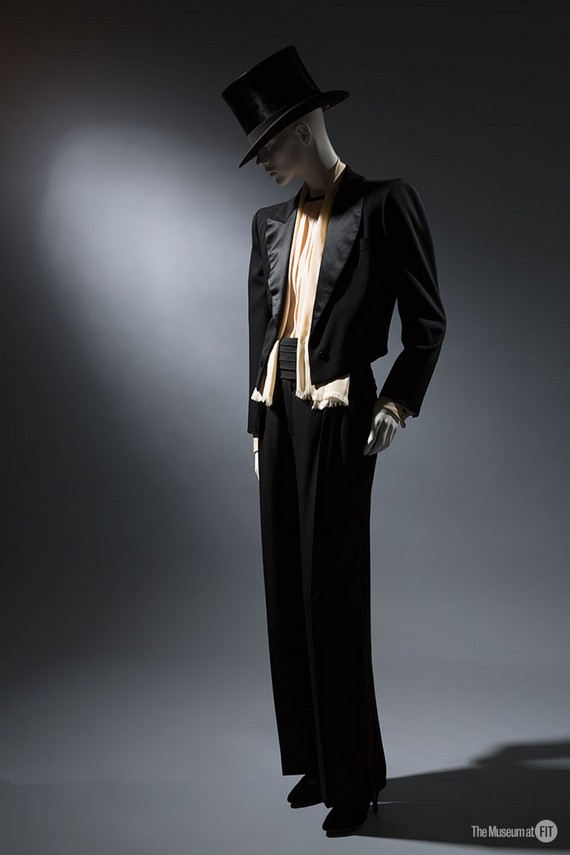
Saint Laurent Rive Gauche smoking evening suit
Yves Saint Laurent founded his couture house in 1962. His most famous contribution to evening wear in the decade was “Le Smoking”, the sexy re-interpretation of a man’s evening suit for women. He also designed the Mondrian inspired heavy silk shift dress in a stark grid formation, with one yellow and one red patch on a white background divided by heavy black lines. This was a dress that was easy to copy for the masses.
Weddings in 1960s womens fashion
The most fashionable wedding dresses in 1960s fashion followed the prevailing trends for short skirts and fun colours, although cream or white and lots of silk and lace with traditional veils predominated.
1960s sportswear in fashion
1960s sportswear took advantage of the advance in man-made fabrics and knit fabrics by using jersey with lycra in stretch ski pants and t-shirts. The US runner Wilmer Rudolph won gold in the 1960 Olympic games in Rome in the tiniest terry cloth shorts and short-sleeved t-shirt, clothes which were completely acceptable on the sports field for women by then.
Swimsuits for 1960s fashion were made from nylon with lycra in for a better fit and drying time than ever before, and could be strapless or not but often featured internal structure and moulded bra sections. The leg line was very low, and skirted models were popular. High waisted two pieces were occasionally seen, and swimsuits came with belts and ruffles, in a variety of bright colours and jazzy patterns.
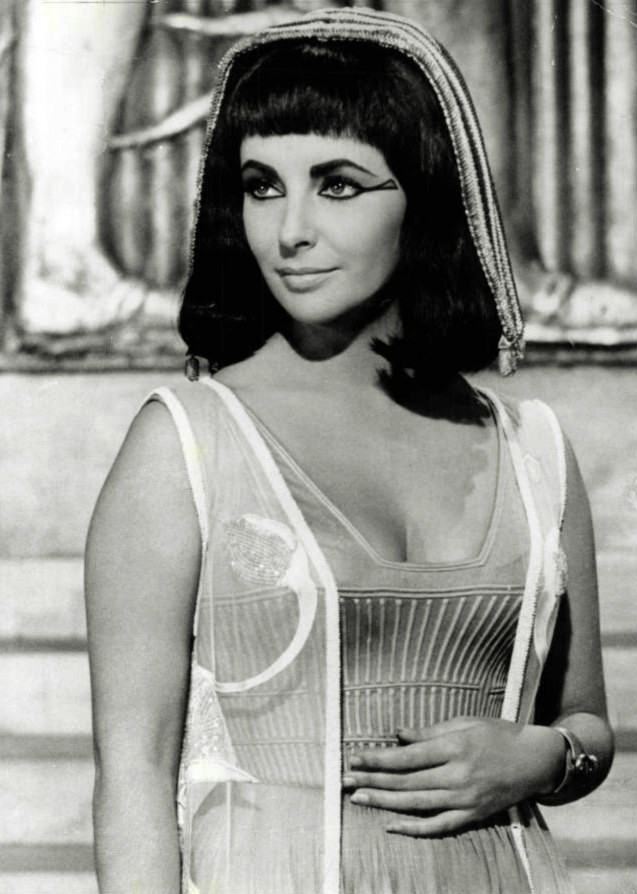
Photo of Elizabeth Taylor from the film Cleopatra, 1963
Perfume and make up in 1960s womens fashion
The big-eyed look was popular in 1960s fashion and many women achieved it by using layers of false eyelashes, and painting on eyeliner in both black and white as well as sometimes painting on the lashes themselves. Lips were painted pink. Grace Coddington, the now legendary stylist of Vogue USA who was a model at the time remembered how there were no makeup artists, and models had to drag around their own make up kit as well as accessories they might need. They invented their own make up looks, fiercely guarding their own signature style.
Elizabeth Taylor in 1963’s Cleopatra influenced this highly graphic eye, and her bold blue shadow was also widely copied without the more daring graphic eyeliner.
The natural look was popular with hippies, and some women for the first time in their lives wore no make up at all.
Perfumes: London was the epicentre of cool and lots of products were named after it. Tuvache’s Oh! de London was one, a bright, sparkling scent. In contrast was the heavy, oriental scent Chamade from Guerlain, and named after the cool Left Bank of Paris was YSL’s Rive Gauche.
Underwear in 1960s womens fashion
The ideal body of 1960s fashion was a skinny adolescent one, so nothing that emphasised the breasts was required. In fact, the most popular bra was the No-Bra Bra, which rather sleazily boasted that it ‘supports yet gives you the natural nude look of a firm, young, bra-less bosom’. Because clothing was becoming shorter and closer fitting, underwear had to be quite subtle. Nothing bulky would fit and seams and ridges, from boning for example, had to be minimised.
You didn’t want anything that would hang below the hem of your skirt either, so knickers became briefer, bras softer and less structured, and tummy girdles, which were still worn, made of smoothing lycra material which had a better stretch and advertised a greater freedom of movement. Tights began to be worn instead of the cumbersome suspenders and stocking arrangement, and light nylon or silk slips worn on top of it all to further smooth the line. An alternative was the nude coloured bodystocking made from stretchy nylon.
Nylon was really coming to the fore in underwear by the 1960s, as it was light, easy to wash and dry, and held colour and bright prints very well.
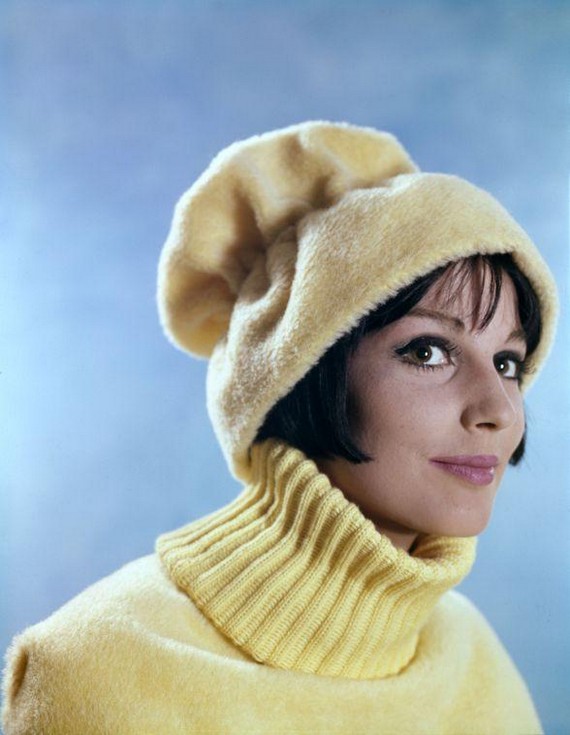
Studio photo of Sophie van Kleef, Dutch top model in the sixties, with a yellow fake fur hat. 1960
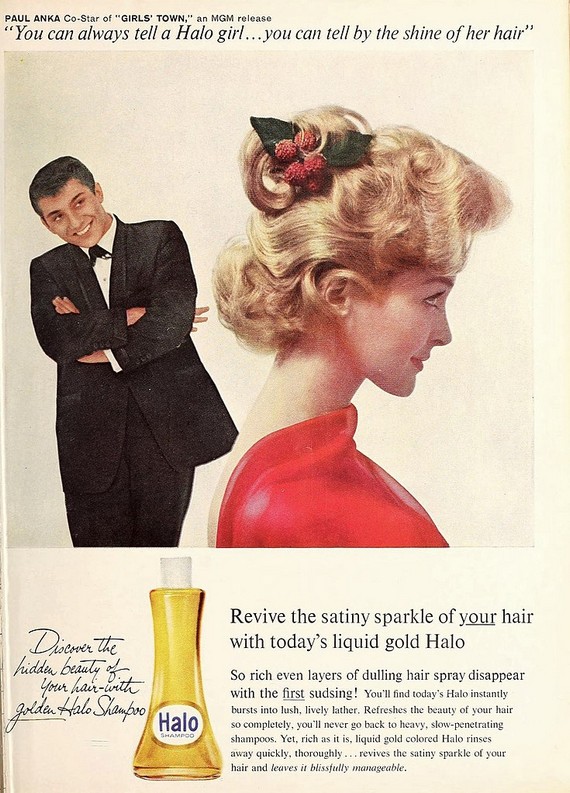
Halo Shampoo ad with Paul Anka, 1960
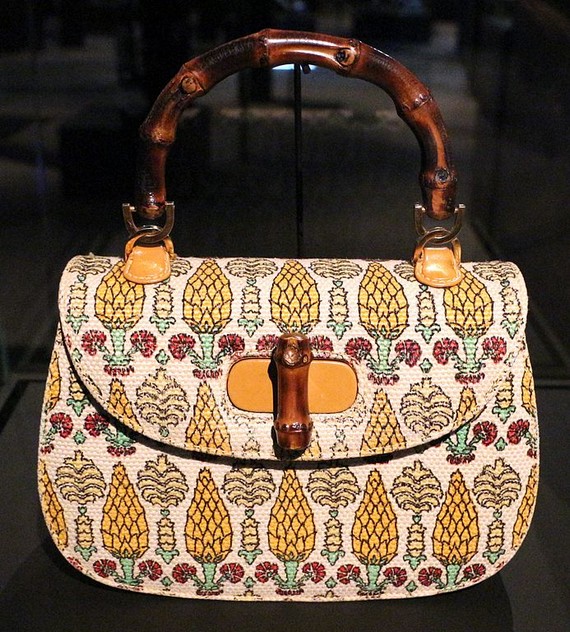
Gucci, bamboo bag, 1960-65
Hats and accessories in the 1960s
For the ladylike look, a structured handbag in co-ordinating colours to your court shoes was a given – a neat pillbox hat was too. The jewellery was a neat brooch to the lapel or classic pearls. Both they and the girls who liked to look fragile and doll-like had collections of big, clip on costume earrings.
The space age designers equipped their models with visors, helmets and balaclavas. Their footwear was knee-length “Go-Go” boots and as accessories, instead of jewellery to clutter the look the designers favoured largely impractical sunglasses with slits or dots instead of lenses to see out of.
Handbags were small and fun and were made of similar space age materials, with silver vinyl bodies and square perspex handles, for example. Jolly little beaded bags with big plastic beads added an accent to a costume and novelty raffia, pearlised or glitter bags were pat of the throwaway aesthetic.
Hippies liked bare feet or Indian sandals, long leather boots for the winter and strings of wooden beads or Indian glass beads along with cowboy hats. Their bags were handmade from patchwork or macrame.
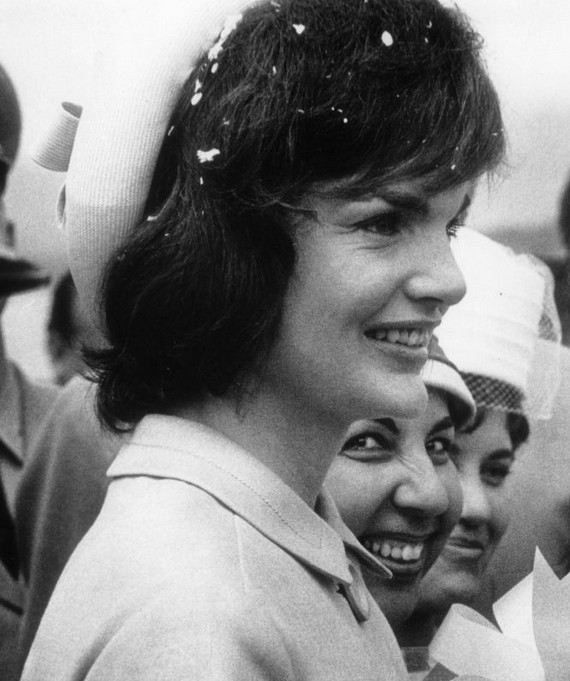
Jacqueline Kennedy in Venezuela, 1961
Hairstyles in the 1960s
Jackie O’s hair was an iconic long bob with curled ends and lots of volume, held in place with tons of hairspray. Volume in hair was massively (get it?) popular in the 1960s, leading to the towering beehive styles of legend. But as a contrast, celebrity hairdresser Vidal Sassoon stepped forward and created something completely different – sharp, geometric styles that you could run your hands through and which would just naturally fall back into place.
Hippies preferred to grow their hair very long, and part it in the middle, often leaving it unwashed or unstyled. A heavy fringe was also popular.
Shop Sixties fashion Here